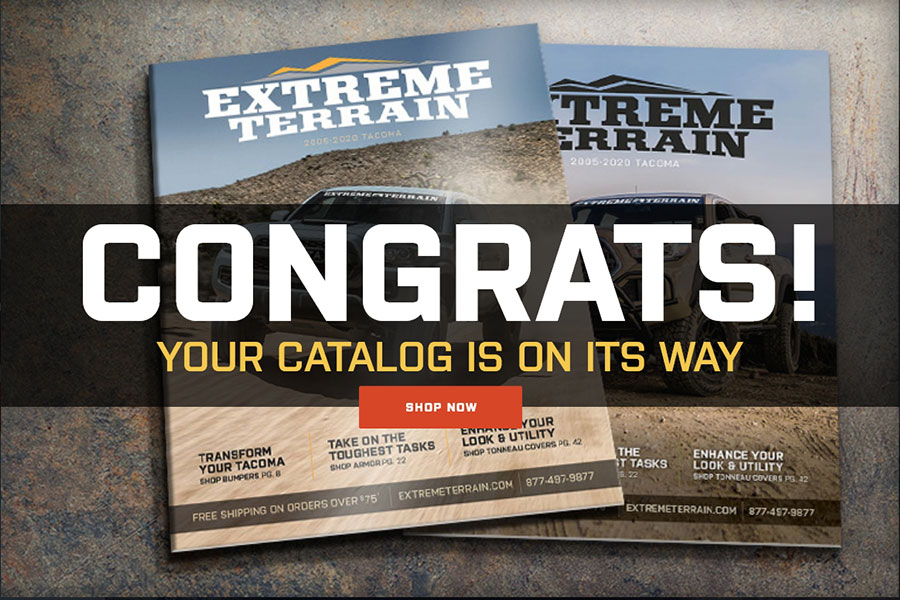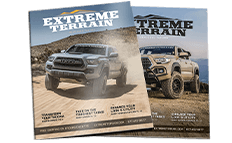2018 Toyota Tacoma
The 2018 Toyota Tacomoa is part of the third generation introduced in 2016, and for this model year, Toyota introduced a suite of newly standard advanced safety aids. With the choice of six trim levels and two body styles, this compact pickup can be powered by either a four-cylinder or V6 engine and either rear or four-wheel drive. The standard 2.7L four cylinder engine will produce 159 horsepower and 180 lb-ft of torque, while the 3.5L turbocharged V6 delivers 278 and 268lb-ft respectively. The V6 does also have the option of being matched with a manual or automatic six-speed automatic transmission. Fully equipped, this Taco can tow up to 6,800lbs and its max payload capacity is 1,620lbs.
Close the Gap
The off-road emphasis -- most notably its lifted stance -- of the 2018 Tacoma means that while every config is ready for the trails, it does also produce a tall step-up for a mid-size pickup. There are a few different options that can help close that gap, namely running boards and side steps. Though similar in design and functionality, there are subtle differences between the two:
- Side Steps: Also commonly referred as side bars and even nerf bars, side steps are primarily designed to provide safer entry and exit to the cab. When mounted, their design produces a gap between the step and the truck’s body, meaning less added protection when compared to running boards. They also mount low, so there is less ground clearance. Side steps will also usually feature an oval or tubular design with custom-positioned step pads to correspond to each of the vehicle’s doors. These step pads can be made from non-slip materials, or are simply a textured tread pattern within the aluminium or steel tubing itself.
- Running Boards: Running boards have two purposes: safer access to the cab as well as added protection for the rocker panels. They mount flush to the Tacoma’s body, offering more ground clearance than side steps as well as extra protection for your Taco’s body. A set of running boards are typically made from lightweight yet high strength and durable aluminium with a wide flat profile, and most will feature a high-grip tread pattern that runs their full length. Depending on the manufacturer, they may also be fully powered and drop automatically when the Tacoma’s doors are opened.
Better Bed Access
Side steps and running boards will provide better access to the cab, but if you’re also needing the equivalent for your bed, then consider a bed step. Mounting directly to the factory locations on the driver side rear bumper area, a bed step is designed to be fully extendable and retractable with the tap of a foot. Manufactured from heavy duty aluminium construction with high-grade steel pins for the pivot points, a bed step’s slip-resistant thermoplastic step pad and for the pivot points can safely handle up to a 300 pound weight capacity.
Modernise Your Lighting
Third gen Tacoma’s rolled out the factory with outdated incandescent bulbs, and their dim, yellow output doesn’t quite match the modern style of these trucks. That’s why one of the most common modifications for 2016 and newer Tacoma’s is swapping out those factory lights -- internal and external -- for more modern alternatives. There are two main types of lights: High Intensity Discharge (HID) and Light Emitting Diodes (LED) lights. HIDs and LEDs are both better than halogen bulbs, but each has their better use case. HIDs produce an incredibly bright and powerful light, but age quickly; LEDs are also bright, more efficient and longer-lasting. In most cases, LEDs do have HIDs beat, but because their technology as yet cannot match the power generated by HIDs xenon systems, the main lights within headlight housings remain HIDs. However, for fog, spot, and tail lights, as well as interior lighting and lightbars, the clear-cut winner is the LED bulb.

















